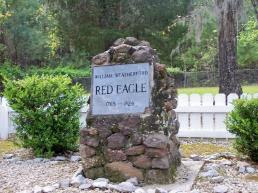A stone cairn in Baldwin County marks the burial place of one of the most noted Indian leaders in American history - William Weatherford.
The son of a white trader and a Creek woman who was a sister of the famed Creek leader Alexander McGillivray, Weatherford was born in Alabama during the 1700s. William's father was not as a breeder of outstanding horses and the family's wealth increased dramatically under the younger Weatherford's guidance during the early 1800s. White settlers flooded to the Tensaw country (north of Mobile), creating markets for horses and other products from Weatherford's plantations.
A friend of the whites for much of his life, William Weatherford assisted in the capture of famed renegade William Augustus Bowles in 1803. In 1813, however, something dramatic happened in his life.
The Creek Prophet Josiah Francis, a disciple of Shawnee Prophet Tenskwatawa, had ignited a religious fervor among many in the Nation. Teaching that the Indians should end all association with the whites and return to their native ways, Francis developed a huge following. His followers were called Red Sticks because the displayed red war clubs in their villages.
There are various stories about how William Weatherford became a Red Stick. Some claim that he joined when his life was threatened. Others tell the story that he became a member of the movement in order to save his family. Benjamin Hawkins, the U.S. Agent to the Creeks, reported in 1813, however, that Weatherford had been captured by the Red Sticks at the Battle of Burnt Corn Creek.
However he joined, Weatherford went on to help lead Red Stick forces at the bloody Fort Mims Massacre in August of 1813 and later fought in other battles against the whites. He surrendered to Andrew Jackson in 1814, but his life was spared and he subsequently fought on the side of the United States against the remaining Red Sticks. When the wars ended, he returned to his plantation on the Alabama River.
To learn more about his grave site in Baldwin County, please visit www.exploresouthernhistory.com/weatherford.
The son of a white trader and a Creek woman who was a sister of the famed Creek leader Alexander McGillivray, Weatherford was born in Alabama during the 1700s. William's father was not as a breeder of outstanding horses and the family's wealth increased dramatically under the younger Weatherford's guidance during the early 1800s. White settlers flooded to the Tensaw country (north of Mobile), creating markets for horses and other products from Weatherford's plantations.
A friend of the whites for much of his life, William Weatherford assisted in the capture of famed renegade William Augustus Bowles in 1803. In 1813, however, something dramatic happened in his life.
The Creek Prophet Josiah Francis, a disciple of Shawnee Prophet Tenskwatawa, had ignited a religious fervor among many in the Nation. Teaching that the Indians should end all association with the whites and return to their native ways, Francis developed a huge following. His followers were called Red Sticks because the displayed red war clubs in their villages.
There are various stories about how William Weatherford became a Red Stick. Some claim that he joined when his life was threatened. Others tell the story that he became a member of the movement in order to save his family. Benjamin Hawkins, the U.S. Agent to the Creeks, reported in 1813, however, that Weatherford had been captured by the Red Sticks at the Battle of Burnt Corn Creek.
However he joined, Weatherford went on to help lead Red Stick forces at the bloody Fort Mims Massacre in August of 1813 and later fought in other battles against the whites. He surrendered to Andrew Jackson in 1814, but his life was spared and he subsequently fought on the side of the United States against the remaining Red Sticks. When the wars ended, he returned to his plantation on the Alabama River.
To learn more about his grave site in Baldwin County, please visit www.exploresouthernhistory.com/weatherford.




